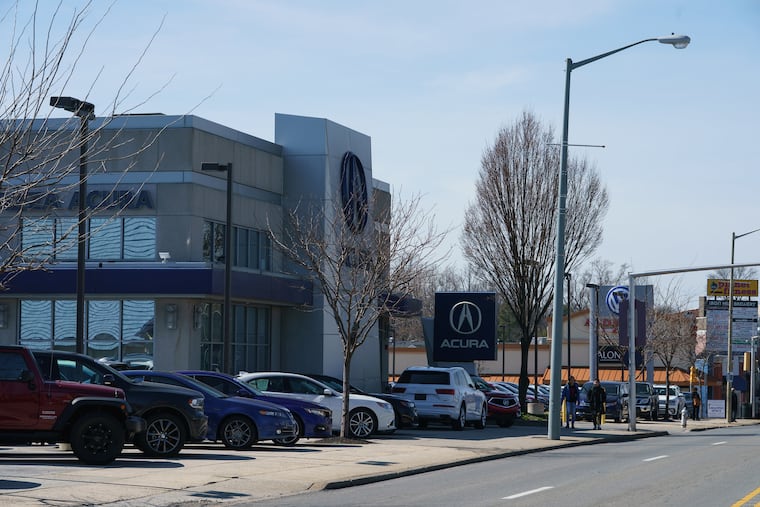Ardmore is getting ready for its transformation — a downtown
As Lower Merion struggles to reconcile its desire for commercial growth with its practical needs, a proposed development could set the tone for Ardmore’s stop-and-go commercial district.

A developer’s plan to transform Ardmore with a retail and housing development where two auto dealerships now stand has riled neighbors and pressed Lower Merion officials into action, suggesting tweaks to what would become the town’s largest apartment complex.
If approved, the complex would replace the Acura and Volkswagen dealerships on Lancaster Avenue with a six-story, mixed-use complex that would have 257 apartments, 122,990 square feet of commercial space, and 840 parking spots.
Located on a highly visible and traversed section of Ardmore’s commercial district, the development could be a linchpin of the town’s vision of an attractive, walkable downtown that abuts residential neighborhoods.
“It’s quite attractive,” Hugh Gordon, president of the North Ardmore Civic Association, said of the development. “It’s redbrick and a lot of glass for the retail component. It’s well and thoughtfully designed.”
But there is worry that it would turn the town into a denser suburban metropolis.
“I feel like it’s too many units at this point,” said Marie Kramer, president of the Ardmore Progressive Civic Association. "A lot of these new developments that are coming in, they are very expensive, and a lot of residents aren’t able to afford them. A lot of these places are going for $2,000 [a month] or more. Affordable housing is a really big issue as to why people are concerned about so much development.”
In keeping with their vision of a pedestrian-friendly commercial heart, township officials have suggested that the developer, Piazza Management Co., include a 10-foot sidewalk along nearby Greenfield Avenue, include on-street public parking on Lancaster Avenue that would “provide traffic calming,” and design the ground floor facade in such a way as to “break up the mass of the building” and create a street-side meeting or dining space.
“Their design team was very receptive to most of our design points," said Chris Leswing, director of building and planning for Lower Merion, the first suburban town in Pennsylvania to adopt a formal zoning code. "It was reflecting good urbanism.”
George W. Broseman, a zoning and land-use lawyer listed as the applicant for the plan, did not respond to requests for comment.
Township officials say they have made a concerted effort to revamp downtown Ardmore, which has 30- to 40-year-old buildings that weren’t built to last. Part of those efforts have been proposed changes to the zoning code, which among dozens of other changes — small and sweeping — includes the suggestion to cap the height of future buildings at less than 65 feet tall in an effort to keep new architecture more congruous with existing structures.
The amendments to the code have grabbed the attention of hundreds of residents who have packed informational meetings for months.
Town officials have touted the proposed zoning changes in the last few months as sweeping measures that they hope will help revitalize Ardmore’s commercial heart and other neighborhoods in Lower Merion by making them pedestrian-friendly communal spaces.
“What we are doing is modernizing and developing," Leswing said.
Blocky structures, particularly along Ardmore’s central business district on Lancaster Avenue, have fallen into disrepair since they were built in the 1960s and ’70s. Poor design contributed to headache-inducing traffic and areas inaccessible by foot. And after a while, Lower Merion officials, displeased with what they saw as an inefficient and less-than-attractive downtown, thought it was time for a change.
“We like commercial uses," Leswing said. "We like a vibrant downtown.”
The township has until June 30 to decide on the future of the Piazza development, which would be grandfathered under the current zoning code but is being asked to comply with the township’s zoning and design requests.
New zoning stipulations for future building projects could be adopted as early as July 31, Leswing said.
“You can’t just freeze things," he said. "Things are always going to grow. How can you manage that growth?”